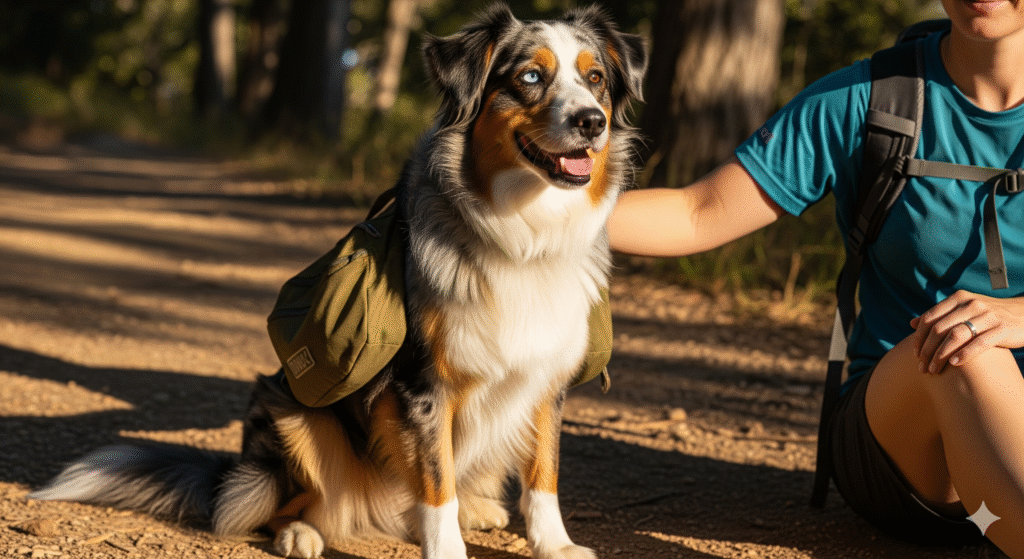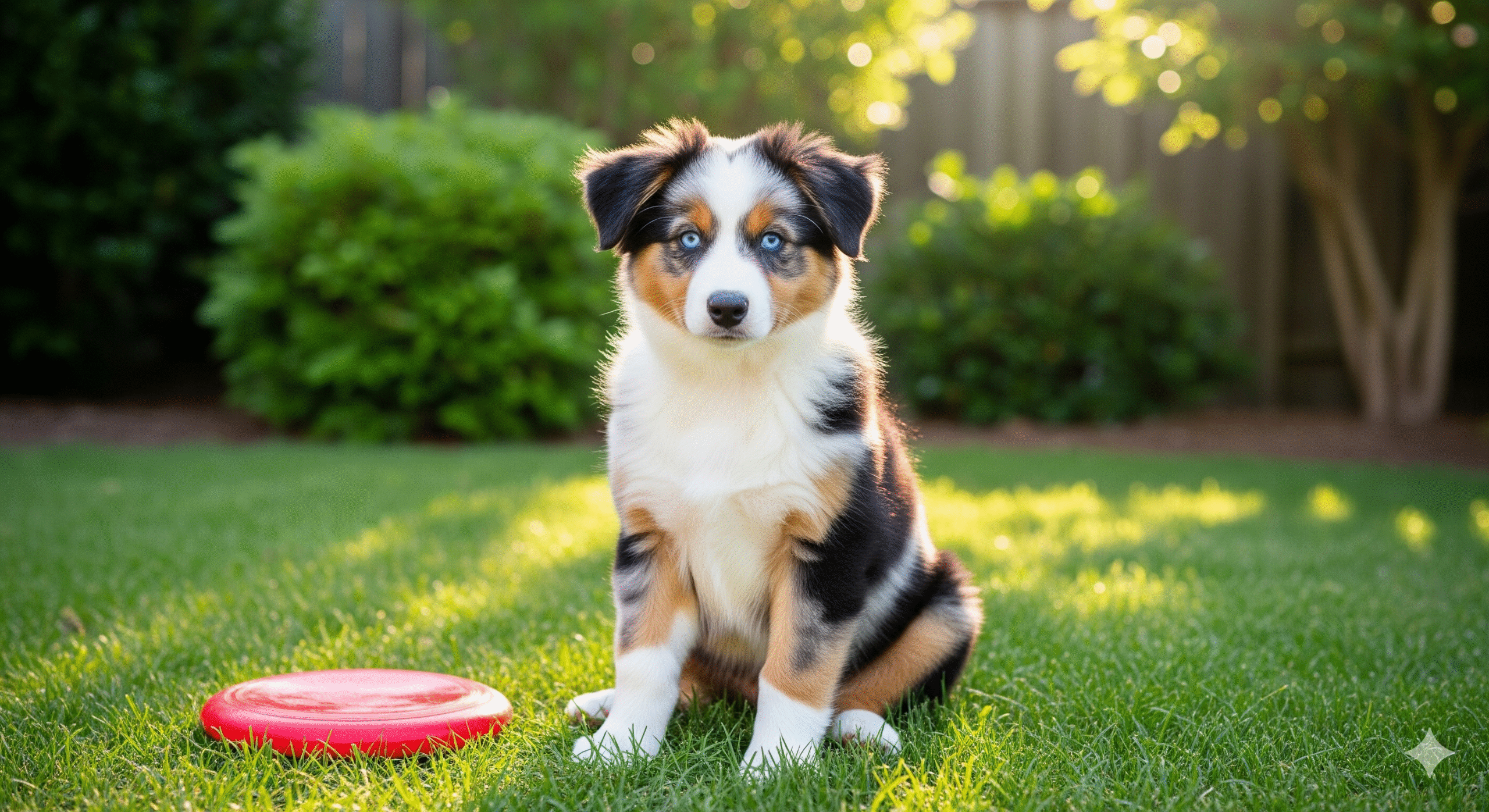Bringing home an Australian Shepherd puppy is like welcoming a fuzzy, four-legged genius into your family. Renowned for their striking merle coats, mesmerizing eyes, and breathtaking intelligence, Aussies are more than just beautiful dogs—they are dynamic working partners bred for stamina and brains. However, that same intelligence and energy that make them so exceptional can quickly become overwhelming in a pet home without proper guidance. Raising an Australian Shepherd puppy isn’t a casual commitment; it’s a lifestyle choice that requires dedication, patience, and a deep understanding of the breed’s needs.
This comprehensive guide is tailored specifically to the unique demands of the Australian Shepherd. We’ll go beyond generic puppy advice to provide you with the breed-specific knowledge to channel your Aussie’s potential into becoming a well-mannered, fulfilled, and incredible companion.
Here’s what we’ll cover:
✔️ Understanding the true Australian Shepherd temperament (it’s not for everyone!)
✔️ Creating a physical and mental exercise routine to prevent destructive behaviors
✔️ Breed-specific training strategies for their smart, sometimes stubborn, minds
✔️ Socialization techniques to ensure a stable, confident dog
✔️ Health considerations common to the Aussie breed
✔️ How to become the leader your herding dog needs to thrive
Let’s embark on the rewarding journey of raising a happy and well-adjusted Australian Shepherd.
The Australian Shepherd Temperament: More Than Just a Pretty Face 🧠
To successfully raise an Aussie, you must first understand what drives them. They are not a sedentary lap dog; they are a purpose-bred working dog.
- Highly Intelligent & Trainable: Aussies are consistently ranked among the smartest dog breeds. They learn commands quickly and excel in obedience, agility, and herding trials. Boredom is your greatest enemy.
- Energetic & Driven: Bred to work all day on a ranch, they have immense stamina and a powerful “on” switch. They need more than just a daily walk around the block.
- Loyal & Velcro Dogs: They form intense bonds with their family and want to be involved in everything you do. They are often reserved or aloof with strangers.
- Herding Instinct: This instinct is strong. They may herd children, other pets, or even your feet by nipping at heels. This is not aggression; it is hardwired behavior that must be redirected.
The #1 Rule: Exercise Their Body AND Their Mind 🏃♂️💡
A tired Aussie is a good Aussie. But “tired” means more than just physical exertion.
Physical Exercise Requirements 🎾
- Minimum 1-2 hours of vigorous activity daily. This is non-negotiable.
- Activities: Long hikes, running, biking (once fully grown), fetch, frisbee, and swimming.
- A fenced yard is highly recommended but is not a substitute for active engagement and structured exercise.
Mental Stimulation: The Key to Success 🧩
This is how you truly exhaust an Aussie’s brilliant mind.
- Advanced Training: Teach them new tricks and commands daily. They thrive on learning.
- Dog Sports: Agility, obedience, rally, herding, dock diving, and nose work are perfect outlets.
- Puzzle Toys: Stuff Kongs, use snuffle mats, and provide challenging food puzzles for every meal.
- “Jobs” Around the House: Teach them to put their toys away, carry a backpack on hikes, or find your keys.
Australian Shepherd Puppy Training: Leadership & Consistency 🎓
Training should start the day you bring your puppy home. Their intelligence means they are always learning, whether you are actively teaching them or not.
1. Channel the Herding Instinct 🐑
- Redirect Nipping: The second they nip at heels, redirect them to a toy they can carry. Teach a strong “leave it” and “drop it” command.
- Provide an Outlet: Consider treibball (“urban herding” with giant balls) or herding lessons with a professional to satisfy this innate drive.
2. Prioritize Impulse Control 🛑
Their intelligence can lead to impulsivity. Teach them to think before they act.
- “Wait” and “Stay” commands for doors, meals, and thresholds.
- “Place” Command: Teaching them to go to a mat and settle is invaluable for calmness.
<H3>3. Socialization is CRITICAL 🌍
- Goal: Expose your Aussie puppy to 100+ people, places, sounds, and surfaces by 16 weeks.
- Focus on Positive Experiences: Their natural wariness means positive associations are key. Pair new experiences with high-value treats.
- Introduce Them to Everything: Traffic, crowds, umbrellas, men with hats, other calm dogs, and different floor types.
Breed-Specific Health Considerations 🩺
Responsible breeding is key. A reputable breeder will provide health clearances for the parents.
- Hip & Elbow Dysplasia: Genetic joint conditions. Ensure parents have OFA or PennHIP clearances.
- Multi-Drug Resistance (MDR1) Mutation: A genetic mutation that makes them hypersensitive to certain common drugs (e.g., Ivermectin). Your vet must be aware your dog is/heritage is an Aussie.
- Progressive Retinal Atrophy (PRA) & Cataracts: Hereditary eye diseases. Parents should have a recent CERF or OFA eye exam clearance.
- Collie Eye Anomaly (CEA): Another inherited eye disorder.
Grooming Your Aussie Puppy ✂️
Their beautiful double coat requires regular maintenance.
- Brushing: 2-3 times per week with an undercoat rake and a slicker brush to prevent mats, especially behind the ears and in the “pants” (back legs).
- Bathing: Every 4-6 weeks or when dirty. Always brush thoroughly before the bath.
- Shedding: Be prepared for significant shedding, especially during seasonal “coat blows.” Daily brushing is needed during these times.
Final Checklist for Australian Shepherd Puppy Success ✅
☑️ I have a plan for 1-2 hours of daily exercise and mental stimulation.
☑️ I have enrolled in a puppy socialization class and basic obedience.
☑️ I have a stash of puzzle toys and am ready to feed meals in engaging ways.
☑️ I have found a veterinarian and informed them about the MDR1 mutation.
☑️ I have the right grooming tools (slicker brush, undercoat rake).
☑️ I am committed to providing clear, consistent leadership.

Ready to Play Fetch Like a Pro? Now that you understand how to effectively tire out your puppy, it’s time to equip yourself with the right gear. The best fetch toy will keep the game going longer and be safe for your puppy’s teeth and joints. For detailed reviews on durability, throwability, and safety, read our buyer’s guide: Best Fetch Toys for High-Energy Puppies.






